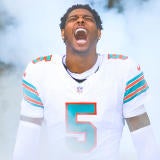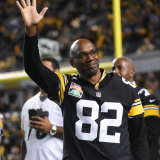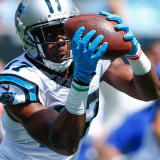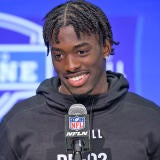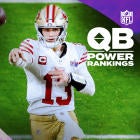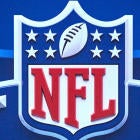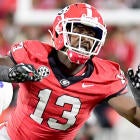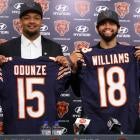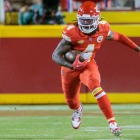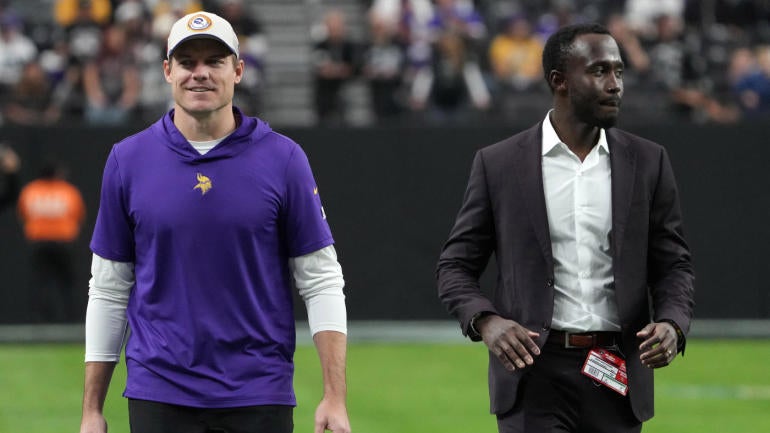
Between me writing a piece covering what it would cost the Giants to trade up in the draft and the piece running on CBSSports.com, the Vikings struck a massive deal that alters the landscape for the first round, acquiring the No. 23 and 232 picks in this draft from the Texans for No. 42, 188 and a 2025 second-round pick. When you plug the picks into our draft pick value chart, which is tweaked every year based on the pick trades teams actually make, the Vikings actually got a little bit of a discount based on how we treat future picks, so it's likely the Texans front office attached more value to that 2025 second-rounder than we did.
In trading for another first-round pick in this draft, the Vikings, in theory, become a more enticing trade partner for any team near the top of the draft considering a trade down, and plenty of mock drafts on our site are projecting a trade up. The question is how competitive the trade market will be for teams looking to move up into one of those top 4-5 slots to take a quarterback. Three teams have moved up into the No. 3 slot in the last six drafts, but the prices paid range from slightly above where we value the pick and slightly above where we value the No. 2 pick.
The 2024 quarterback class is unlikely to be as highly graded from No. 1 (Caleb Williams) to No. 4 (likely J.J. McCarthy for many teams) as that 2018 class, but it's possible there's just as much competition to move up. The Commanders at No. 2 and the Patriots at No. 3 would likely need to be blown away to move down considering their QB need, but we can't rule that scenario out if they aren't 100% sold on the available prospects and if they're presented with enough of an overpay for the pick. The Broncos and Raiders are picking right after the Vikings and have their own QB questions, with Jarrett Stidham and Gardner Minshew, respectively, likely in line to start if no other additions are made. We'll cover what both will need to do to move up in future content, but today's piece is about the Vikings.
In this space, we're going to examine what it would take for the Vikings to trade up to No. 2, 3, 4 or 5 using my draft pick value chart. I developed the chart years ago when I was the NFL Draft editor at CBS Sports and have maintained it ever since so that our team could continue to use it to put together realistic trades based on how teams have valued draft picks in recent years. The way the chart works is that a team that wants to trade up typically needs to beat the listed value of a pick for a trade to happen, though there are always a few cases where the team moving down takes slightly less.
Last year, the first picks-only trade happened at No. 3, where the Texans gave 667.73 points of value for a pick valued at 658.52 points (after subtracting the value of the extra pick included by the Cardinals). But the context of the draft also matters, as that trade was for pass rusher Will Anderson Jr. rather than a QB. Two years prior, the 49ers surrendered 704.47 points of value to make the same move from 3 to 12 for a quarterback without knowing which would be available. And in 2018, the Jets surrendered 803.92 points of value (more than our current valuation of the No. 2 overall pick) to get from 6 to 3, also without knowing who would be available but in a QB class that was generally considered one of the best of all-time in the moment.
The 2024 quarterback class is more in line with 2021 than 2018 on the surface, with one standout at the top and then questions about the order thereafter (Zach Wilson, Justin Fields, Trey Lance and Mac Jones in 2021; Drake Maye, Jayden Daniels and J.J. McCarthy this year). That means the Patriots should expect to get anywhere from the 658.52 points of value we've set as the baseline for the No. 3 pick to 50 points more to reflect the 49ers deal from 2021 if they are to move down, and potentially more if there's a competitive market for the pick like we assume there was in 2018.
Last year, we did something similar with the trade-down scenarios for the Bears, including with the Panthers, and the feedback was mostly that there's no way they'd get as much as our proposed deals. But if you value D.J. Moore in the range of draft pick compensation used to acquire A.J. Brown and Marquise Brown in recent drafts, we basically nailed the baseline value of the deal in our pick chart. Below, we're going to cover what it would take for the Vikings to move up with each team in the top five in a draft pick trade, each with three different scenarios for trading the pick (baseline value, medium value, competitive-market value) when possible.
For more draft coverage, you can hear in-depth analysis twice a week on "With the First Pick" -- our year-round NFL Draft podcast with NFL Draft analyst Ryan Wilson and former Vikings general manager Rick Spielman. You can find "With the First Pick" wherever you get your podcasts: Apple Podcasts, Spotify, YouTube, etc. Listen below!
Trading to No. 2
Baseline value
- Vikings receive No. 2 (777.06 points)
- Commanders receive No. 11, No. 23, No. 108, 2025 first-round pick and 2025 third-round pick (788.29 points)
In these deals, we value future picks as the round of the pick times 32, so roughly as the last pick of the round in the current draft. But teams will have different values on these picks based on things like their overall strategy, the projected quality of the team tied to the pick in the relevant year, and so on. This trade would leave the Vikings with just one selection in the first two days of the next two drafts (No. 2 overall in 2024), but it's the baseline for what they'd need to give up for the Commanders to even consider making a deal.
Medium value
- Vikings receive No. 2 (777.06 points)
- Commanders receive No. 11, No. 23, No. 108, 2025 first-round pick and 2026 second-round pick (828.85 points)
If the Commanders don't put a severe discount on a pick two years out instead of one, this is a way for the Vikings to complete a similar overpay to what the 49ers did to move up to No. 3 and ultimately take Trey Lance. That deal also included a pick two years out, so it's a good one to use for comparison, and there were several teams that year that needed a quarterback, with two more ultimately going in the top 15 picks.
And yet, with the Commanders' need at QB, this probably isn't enough to get a deal done either.
Competitive-market value
- Vikings receive No. 2 (777.06 points)
- Commanders receive No. 11, No. 23, 2025 first-round pick and 2026 first-round pick (898.96 points)
The Jets-Colts deal featured the Jets paying over the value of the pick above where they ultimately landed, and this would almost do the same. While the Commanders need a QB, could they say no to four first-round picks? They could take a shot at a second-tier QB at No. 23 or early in the second round, and still have ammunition to go after a QB in two future drafts if it doesn't work out.
I believe this is a deal Washington would ultimately accept once they're 100% sure Caleb Williams is going No. 1, but I don't believe the Vikings would pay this much of a premium to get to No. 2.

Pick Six Newsletter
Crafted By The Best NFL Experts
Get the day's big stories + fun stuff you love like mock drafts, picks and power rankings.
Thanks for signing up!
Keep an eye on your inbox.
Sorry!
There was an error processing your subscription.
Trading to No. 3
Baseline value
- Vikings receive No. 3 and No. 68 (725.80 points)
- Patriots receive No. 11, No. 23 and 2025 first-round pick (729.53 points)
The Patriots are a pretty interesting trade partner for someone like the Vikings looking to deal up. They seemingly are far more than a quarterback away from competing as they enter the post-Bill Belichick era, so would they be more interested in pushing back the decision to draft a quarterback rather than sacrifice valuable rookie-deal years with a less competitive team? If the alternative is getting three first-round picks, it's something New England should consider doing. The Vikings are also able to get back into Day 2 of this year's draft in this baseline scenario.
Medium value
- Vikings receive No. 3 and No. 137 (671.76 points)
- Patriots receive No. 11, No. 23 and 2025 first-round pick (729.53 points)
This isn't much different than the scenario above, with the only change being which pick the Vikings get back from the Patriots in this year's draft. If the market for the No. 3 pick isn't super competitive, this may be a realistic deal for the two sides to strike, or even upgrading this fifth-round pick to the Patriots' fourth-round pick (No. 103) for some middle ground between the baseline and medium-value offers.
Competitive-market value
- Vikings receive No. 3 and 2025 fourth-round pick (674.35 points)
- Patriots receive No. 11, No. 23, 2025 first-round pick and 2025 third-round pick (763.23 points)
A simple competitive-market value deal would just be No. 3 for the three first-round picks we've included in every deal, without the Vikings getting anything else back. If that's not enough to get it done, I think one more one-round pick swap in 2025 would push it over the edge.

Pick Six Newsletter
Crafted By The Best NFL Experts
Get the day's big stories + fun stuff you love like mock drafts, picks and power rankings.
Thanks for signing up!
Keep an eye on your inbox.
Sorry!
There was an error processing your subscription.
Trading to No. 4
Baseline value
- Vikings receive No. 4 (577.65 points)
- Cardinals receive No. 11, No. 23, No. 129 and No. 230 (577.72 points)
The two first-round picks themselves are enough to get pretty close to the value of the No. 4 pick, so the Vikings may be able to swing a deal without surrendering any future capital in this scenario. There'd also likely be less of a market for picks if quarterbacks are taken 1-2-3, as other potential suitors may not be able to get the QB they wanted and have no interest in settling for the fourth QB on their board. The question is whether the Vikings would be in the same boat or still looking to move up for someone they believe will be a franchise quarterback.
- Vikings receive No. 4, No. 66 and 2025 second-round pick (722.60 points)
- Cardinals receive No. 11, No. 23 and 2025 first-round pick (729.53 points)
Here's an alternative scenario where the Cardinals are able to get three first-round picks out of the Vikings, while Minnesota is able to get back into Day 2 this year and the second round next year. That softens the blow a bit in giving up three firsts, and while it takes the Cardinals out of getting a blue-chip receiver, the depth at the position in this year's class means they could hit the position with one (or even two) of what would be three picks from No. 23 to 35 while being able to use No. 11 and the Vikings' first-round pick next year on other premium talent.
Medium value
- Vikings receive No. 4, No. 66 and No. 90 (687.42 points)
- Cardinals receive No. 11, No. 23 and 2025 first-round pick (729.53 points)
This is essentially the same as our alternative baseline value deal, but the Vikings only get back the 90th pick this year instead of a second-rounder next year. This should be the high end of what they'd have to pay to get the pick from the Cardinals if three quarterbacks are already off the board.
Competitive-market value
- Vikings receive No. 4 and No. 66 (648.34 points)
- Cardinals receive No. 11, No. 23 and 2025 first-round pick (729.53 points)
The same deal again as in our medium-value section but without the third pick coming back to the Vikings. This is likely to be too much for Minnesota to pay unless something strange goes on in the first three picks.
Trading to No. 5
Baseline value
- Vikings receive No. 5 and No. 69 (586.05 points)
- Chargers receive No. 11, No. 23 and No. 108 (585.16 points)
If the Vikings are still in a position where the quarterback they want is available at No. 5, the Chargers would surely make sure they're able to get the No. 23 pick back in any deal. Here's a scenario that makes sense, with the value of No. 5 not at the level of the Vikings' two first-round picks combined. This is also a potential "slingshot" situation, where the Vikings may be able to convince the Patriots to trade down to No. 5 if they're steadfast in not wanting to trade to No. 11 by using their 2025 first-round pick and potentially also getting something else back (a 2025 third-round pick?)
Medium value
- Vikings receive No. 5 (520.41 points)
- Chargers receive No. 11 and No. 23 (560.10 points)
The simplest potential trade on the board for these teams should be enough to get the Chargers to say yes prior to draft night, but again, the Vikings probably want assurances from the Patriots they'll be able to move up further before striking that type of deal.
Competitive-market value
- Vikings receive No. 5 and No. 37 (665.06 points)
- Chargers receive No. 11, No. 23, No. 108 and 2025 first-round pick (754.59 points)
In a situation where there is actually a competitive market for a quarterback still on the board, the Vikings are probably stuck moving three first-round picks, but they should be able to expect a pretty significant pick swap from No. 108 to 37 in order to make that deal.
Prediction
I'll still go through the exercise of building trades for the Broncos and Raiders in future content, but it really feels like the Vikings have signaled they'll do what it takes to get into position to draft a quarterback. I think it'll ultimately result in making two moves, a la the Carson Wentz trade of 2016 that saw the Eagles move from No. 15 to No. 8 to No. 2.
- Vikings receive No. 5 (520.41 points)
- Chargers receive No. 11 and No. 23 (560.10 points)
With the Chargers not in the market for a QB, they should be willing to take a deal where they have a pretty clear advantage, like the Dolphins did in 2021 when they flipped the No. 3 for the No. 12 pick and two other first-round picks, then used one first-round pick to move back up to No. 6. The gap between the No. 5 and No. 11 pick is roughly similar to the gap between the No. 3 and No. 6 pick.
- Vikings receive No. 3 (658.52 points)
- Patriots receive No. 5 and 2025 first-round pick (689.83 points)
In both these deals, the Vikings are sacrificing enough value that the other teams should be open to accepting. It feels like a lot giving up three first-round picks; the 49ers did exactly that and also included a future third to get from No. 12 to No. 3 three years ago, but those future firsts are worth less in our chart than the No. 23 overall pick.
Still this is a relatively simple solution for the Vikings to consider in their quest for a quarterback. The Patriots lose out on drafting a QB but may not be in the best position as an organization to take one anyway, and their consolation prize will be a blue-chip receiving talent they also desperately need, as well as what could be a pretty high first-round pick next year with the Vikings likely starting a rookie under center. The Chargers lose out one of the top two receiver prospects, but there might also be a silver lining given the fact they just spent a first-rounder on a receiver and they might not want to go back to the well at the position so quickly, especially with the depth later in the draft and so many needs on the roster.
And who knows? This might lead to another trade where the Giants get locked out of a QB and are willing to move down to 11, letting the Chargers come right back up and draft the guy they would've taken at 5 anyway. Moving No. 11 and 37 would be enough to get over the baseline value of No. 6, so if the Giants are game, the Chargers could effectively move up 14 spots from No. 37 to 23 and still get their guy.







